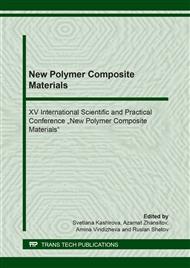p.14
p.19
p.27
p.33
p.37
p.43
p.48
p.55
p.61
Investigation of Carbon Fiber/Polyphenylenesulfone Composites by Method of X-Ray Photoelectron Spectroscopy
Abstract:
The surfaces of polyphenylenesulfone samples with the addition of carbon fibers were studied by X-ray photoelectron and Auger-electron spectroscopy. The state of carbon atoms on the surface, the electronic structure, and the distribution of carbon fibers in the surface region as a function of the concentration of the additive were studied. It is shown that with 10 mass. % carbon fiber addition, the transformation of peaks is mainly associated with an increase in the number of carboxyl groups in the matrix, while with a carbon content exceeding 10 mass. %, the increasing role of differential vertical charging becomes the dominant factor. A further increase in the carbon fiber concentration leads to an increase in the conductivity of the bulk part and, consequently, to a decrease in the charge layer without carbon fiber, and therefore, to a decrease in the broadening effect of the C 1s carbon peak.
Info:
Periodical:
Pages:
37-42
Citation:
Online since:
August 2019
Price:
Сopyright:
© 2019 Trans Tech Publications Ltd. All Rights Reserved
Share:
Citation:


